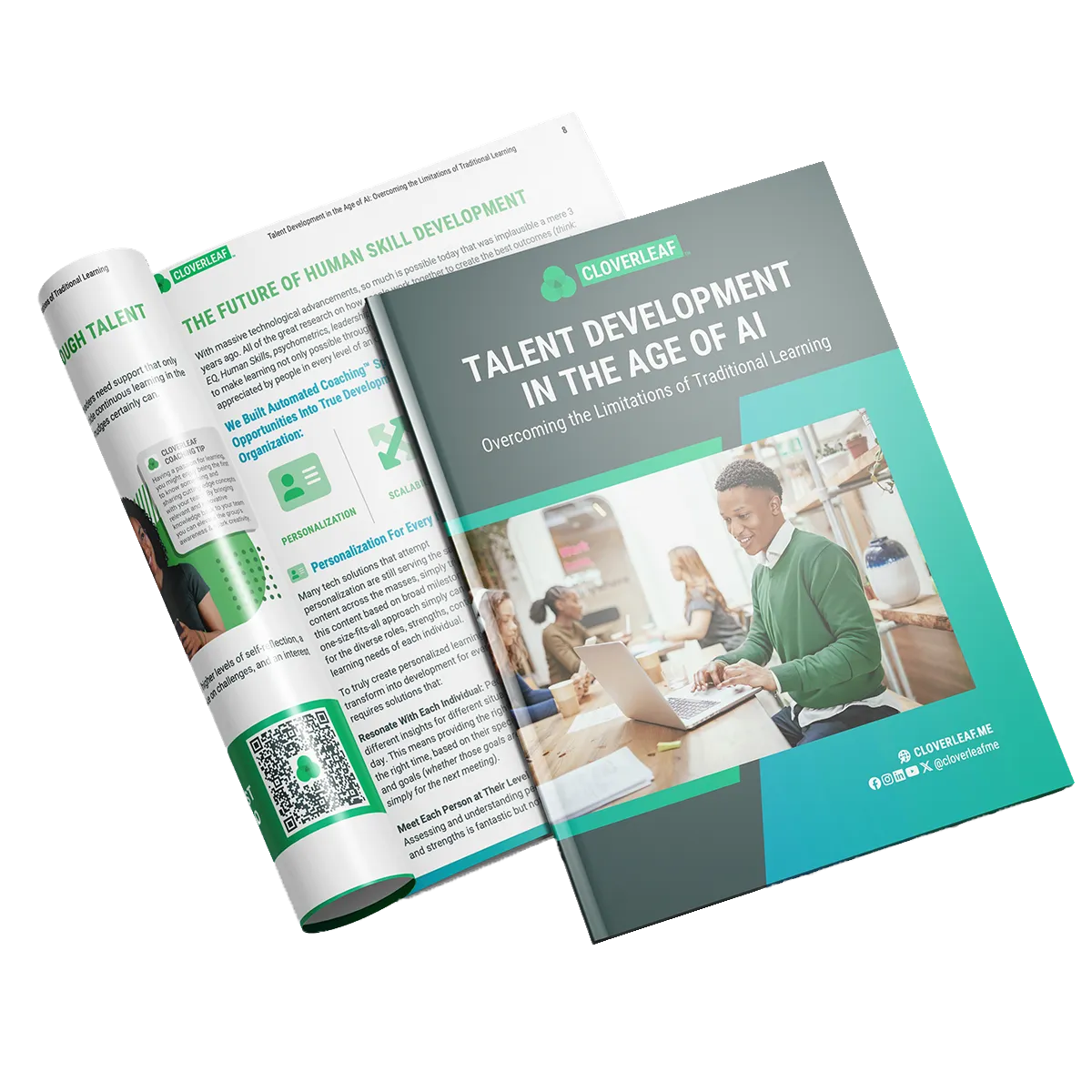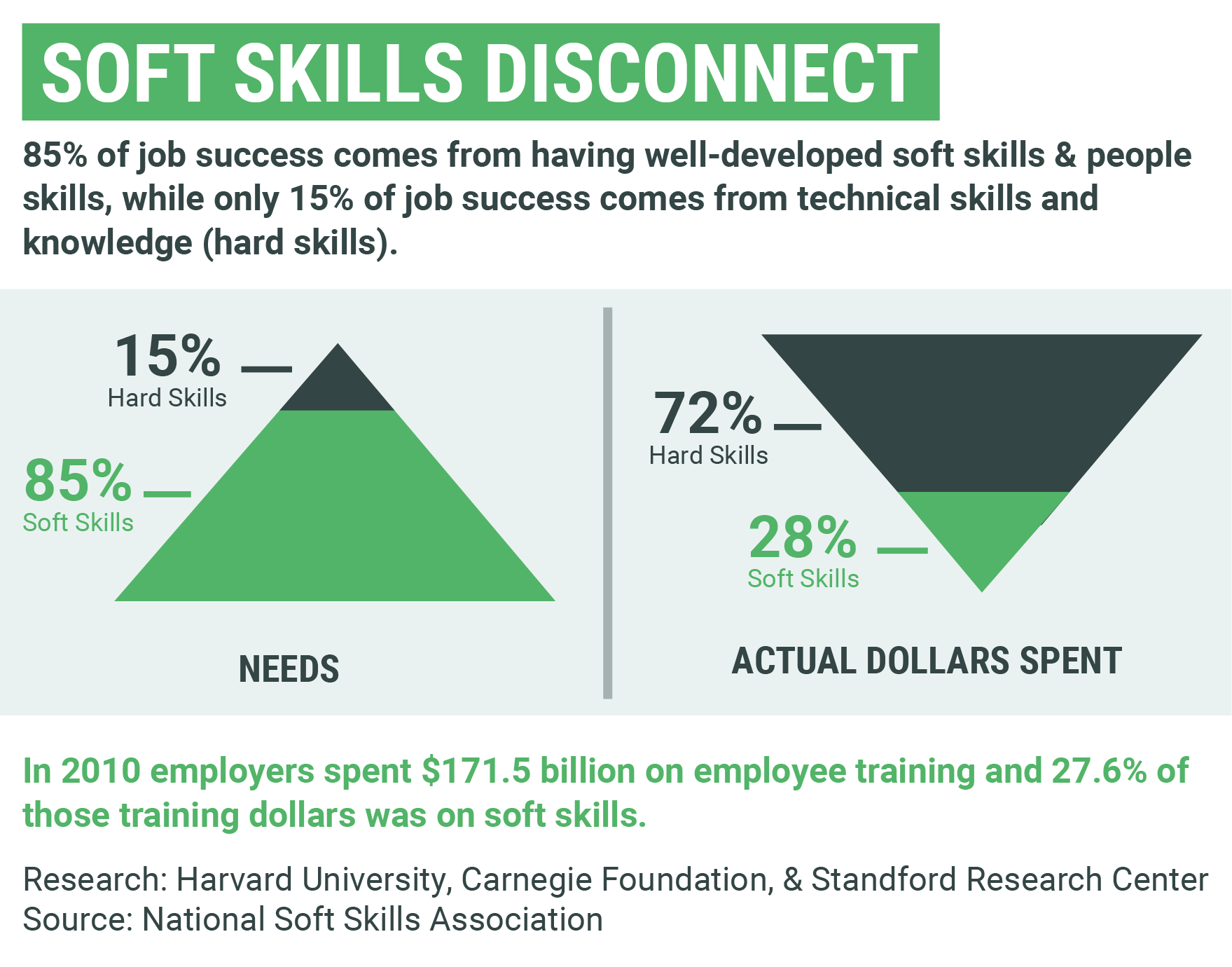In this new era, we need a more scalable and “sticky” way to elevate collaboration across our organizations. It’s imperative. Collaboration is already making or breaking projects and organizations, and with the increasing pace of work, the need for effective collaboration is only growing. We must change our tactics to achieve consistently high-quality collaboration, or our personal and collective success—and wellbeing—will suffer.
Organizations face numerous challenges in this area. By and large, they don’t define, measure, or invest in collaboration effectively. While the term is often used, real investment and measurement reveal a wide variety of gaps. Collaboration, cross-functional teamwork, and related skills are rarely trained for or measured. When training does occur, it’s usually focused on individuals, typically leaders, who are then expected to apply these skills in teams that lack similar training. This siloed approach, if it exists at all, often falls short.
Investing in the quality of collaboration is often relegated to the category of “soft skills,” implying it’s less valuable. This perception persists because the industry hasn’t cracked the code on measuring collaboration effectively and proving its connection to profits. However, focusing on human skills like communication, empathy, and teamwork can transform the way organizations operate. By embedding these skills into daily practices, organizations can strengthen trust, innovation, and agility, ultimately turning human skills into a competitive advantage.

The Limitations of Traditional "Collaboration Tools"
In the broader technology market, many products are labeled as “collaboration tools.” However, these tools are mostly just communication or productivity tools. Few, if any, of the software tools currently classified as collaboration actually focus on the human (behavioral) element of collaboration.
Simply providing another channel to communicate doesn’t necessarily improve collaboration. In fact, it can often be a barrier by introducing confusion about where and how to communicate with each other. More channels can be more confusing if there isn’t a shared understanding of which channels to use and when. This often leaves people questioning where to expect a response from teammates. Email, Slack, or text? No one knows.
This Harvard Business Review survey found that while organizations use various tools to share words and files, these tools often fail to enhance true collaborative efforts. The survey revealed that while communication tools facilitate message exchange, they do not necessarily improve the effectiveness of these messages to create shared understanding and meaningful collaboration. We have too many ways to transfer messages and not enough support to build true relationships and quality communication.
We need new tools and approaches that address the work humans do to navigate our differences and achieve outcomes that build true value for the organizations we serve.

HUMAN SKILL PROGRAMS ARE HITTING LIMITATIONS...
- Close the widening gap between learning and on-the-job application
- Overcome the tension of pausing productivity for development opportunities
- Integrate learning so it is actually in the flow of work
- The evolution of human skill development
- What Automated Coaching™ is and how it works.

Growing Collaboration Beyond Communication Tools
- Overwhelming Channels: Multiple communication platforms can lead to confusion about where to communicate.
- Lack of Focus on Relationships: Effective collaboration requires tools that foster understanding and relationships, not just message exchanges.
- Missing the Behavioral Aspect: True collaboration involves navigating human behaviors and differences, which current tools do not adequately support.
The Need for Human-Centered Collaboration Tools
To truly improve collaboration, we need tools that:
1. Facilitate Understanding: Tools should help team members understand each other’s strengths, communication styles, and working preferences right in the flow of work. (Josh Bersin).
2. Build Relationships: Effective collaboration tools should focus on relationship-building and trust. (mckinsey.com)
3. Support Behavioral Changes: Tools should provide insights and nudges that help teams navigate differences and improve their collaborative efforts. Continuous learning and development platforms that offer real-time coaching and feedback can drive sustained behavioral change to improve collaboration.
Shifting the focus from mere communication to understanding and relationship-building, organizations can unlock the true potential of collaboration.
The Misnomer Of “Soft Skills“
Unfortunately, what we’re talking about here is often lumped into a broader category in the organizational context referred to as “soft skills.” This is a really annoying moniker on many levels for those of us who have dedicated our lives to improving people and organizational effectiveness. The word “soft” would seem to imply that it’s less necessary or less relevant than hard skills like software development or financial forecasting. This is also why many in talent management circles have started referring to these soft skills as “human skills”—an even more appropriate moniker in an era of artificial intelligence.

The Value of Human Skills
CFOs often like to gloss over these investments in soft skill training as frivolous and the most expendable when budget cuts are necessary. This disconnect is illustrated clearly when we examine where we are investing our talent development dollars versus what the organization and its leaders identify as the most critical skills for business success.
Despite the pervasive influence of Artificial Intelligence (AI) tools, human skills are the least likely to be displaced or replaced by AI. These skills offer exponential returns on investment compared to the incremental returns of most hard skills. For instance, learning how to use Excel better or adopting a new sales technique might improve efficiency marginally. However, understanding your teammates’ unique strengths can help avoid unnecessary conflicts and navigate differences toward significantly higher performance.
The Return on Investment (ROI) of Human Skills:
- Conflict Avoidance and Performance: A better understanding of human skills can help teams avoid conflicts and work more harmoniously, leading to higher productivity and better results.
- Market Relevance: Insights into human skills can guide the development of products and services that better meet customer needs, enhancing market success.
- Enhanced Customer Interactions: Skills in empathy, communication, and problem-solving improve customer support and sales effectiveness.
3 Challenges of Measuring Human Skills Impact
The disconnect between the investment in development dollars and the types of skills that have an outsized impact on performance boils down to measurement issues.
Challenges in Measuring Collaboration Health:
1. Lack of Standardization: There is no standardized way to measure soft skills across different organizations, making it difficult to benchmark or track progress uniformly.
2. Isolation of Impact: It is challenging to isolate the specific impact of a human skills intervention from other variables that influence performance.
3. Linkage to Financial Success: Drawing a direct and clear line between improvements in human skills and financial metrics like revenue growth or churn rates is complex and often indirect.
Let’s look at each of these in more detail.
1. The Need for Standardized Measurement in Human Skills
When discussing gross margin, businesses can quickly provide a percentage that reflects a standardized calculation. Unfortunately, such standardization for human skills and collaboration metrics is lacking. While we can measure turnover and engagement, how do we quantify collaboration, psychological safety, trust, or leadership?
Measuring Human Capital: SEC’s Steps
The SEC has recognized this gap. On August 26, 2020, they mandated that companies disclose their human capital resources in quarterly and annual reports. This includes any human capital measures or objectives that are key to managing the business.
Trends in Human Capital Reporting
Gibson Dunn’s study on the S&P 500’s compliance reveals significant variability in disclosures:
- Disclosures ranged from 109 to 1,995 words, averaging 960 words.
- 25% of companies avoided quantitative metrics, and 10% included only headcount numbers.
- Significant increases in disclosures on talent attraction, retention, compensation, diversity, health, and pay equity were noted.
There is no standardization in human capital metrics across companies. This variability underscores a lack of understanding of the value human skills bring to organizational success.
The SEC’s requirements are a start, pushing us towards more transparency and investment in people. International standards like ISO 30414 offer some guidance but remain voluntary.
By moving towards standardized measurements for human skills, organizations can better align investments with the factors that drive success, ultimately gaining more actionable insights into their most valuable assets: their people.
2. Isolating the Impact of an Intervention
Organizations invest $350 billion annually in learning and development (L&D) across various interventions, including online courses, in-person training, assessments, coaching, and more. How do we measure the impact of these development opportunities?
Consider an employee named Raj, who improved his performance after participating in multiple programs and moving to a new team with a new manager. How can we determine whether his performance boost was due to the training, the new team, or the new manager?
Current Measurement Practices: Many L&D leaders rely on surveys to gauge effectiveness:
- Surveys ask if the training was helpful.
- Surveys ask if managers are effective.
- Surveys ask if employees feel they have access to needed development programs.
Limitations of Surveys
- Sentiment vs. Metrics: Surveys measure feelings, not direct ties to business metrics like revenue or turnover.
- Survey Fatigue: People are tired of surveys, leading to low completion rates.
- Time-Based Approach: Pre- and post-intervention surveys measure short-term changes, but it’s hard to ensure lasting impact. Studies show that most training knowledge is forgotten within a week.
How can you know if someone’s behavior change will stick? Study after study shows that people forget most of what they learn in training courses within a week. How can development professionals truly measure if their programs create lasting change for months and years?
3. Linking Investments to Financial Success
How do investments in people translate into financial success? While studies show that companies investing in salary, benefits, or L&D are more productive, proving a direct link is tough.
How do investments in people translate into financial success? While studies show that companies investing in salary, benefits, or L&D are more productive, proving a direct link is tough. Demonstrating the ROI of collaboration is even harder. Before Organizational Network Analysis (ONA), quantifying collaborative activity was nearly impossible. Now, tools like Microsoft 365, Google Suite, Slack, Salesforce, and GitHub generate vast data showing who is connecting and communicating within teams.
ONA can identify key connectors, highlight areas of isolation, and pinpoint communication breakdowns. However, it still doesn’t easily link these activities to financial metrics. It measures communication quantity, not quality. High volumes might indicate miscommunication, gossip, productive brainstorming, disengagement, or efficient alignment.
Organizational Development leaders face challenges in proving the impact of leadership programs on emotional intelligence and psychological safety, which are crucial for reducing turnover, increasing engagement, and accelerating innovation. Surveys can gauge sentiment but often fail to show direct ties to financial outcomes. This gap makes it hard to secure budget approval for development initiatives without leaders’ belief in the value of investing in people.
Unlocking the Potential of Quality Collaboration
Valuable collaboration is under-invested because we think of it in terms of quantity or channels rather than quality. We lack a common language and numerical proof linking it directly to profit. However, effective collaboration leads to profit and enhances the quality of life for employees and customers.
The convergence of macro-trends, SEC requirements for human capital considerations, and technological advancements present an opportunity to empower effective human skill interventions and measure high-quality collaboration’s impact.
The explosion of data and new techniques promises a future where we better understand how collaboration impacts productivity, innovation, and value creation. For now, approaches remain inconsistent across companies and teams.
At Cloverleaf, we have a front-row seat with millions of people in tens of thousands of teams across hundreds of organizations both large and small, for what is working and what is ineffective in collaboration. We built Automated Coaching around proven concepts that work, grounded in decades of research and validated by real-world applications, resulting in quality collaboration, value creation, and life-changing outcomes. To see Cloverleaf in action or schedule a demo, click here.







